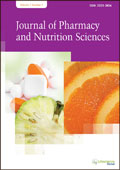jpans
|
|
Abstract: Background: Oxidative stress induced by hyperglycaemia plays a crucial role in the development of diabetic complications and metformin is commonly used in treating diabetes mellitus (DM). The aim of this study was to investigate whether metformin at the dose of 100 mg/kg/day could ameliorate oxidative stress and improve plasma insulin level in streptozotocin-induced diabetic rats. Methods: Twenty one rats (8-10 week old; weighing 190-220 g) were assigned into three groups (n=7 rats per group) i.e. non-DM, DM and DM+metformin (100 mg/kg/day metformin) groups. DM was induced using streptozotocin (60 mg/kg) intraperitoneally and treatments were given daily by oral gavage for four weeks. The levels of plasma biomarkers such as fasting blood glucose, oxidant-antioxidant markers and insulin levels were analysed. Results: Fasting blood glucose, malonyldehyde and protein carbonyls levels were significantly higher while insulin, total antioxidant capacity, catalase and glutathione peroxidase levels were significantly lower in DM group compared to non-DM group. The levels of fasting blood glucose, malonyldehyde and protein carbonyls were significantly lower while levels of total antioxidant capacity, catalase and insulin were significantly higher in DM+metformin group compared to DM group. Conclusion: This study may suggest that metformin at the dose of 100 mg/kg/day for 4 weeks reduces oxidative stress status and improves plasma insulin level in streptozotocin-induced diabetic rats possibly through its antihyperglycaemic action. Keywords: Oxidative stress, rats, diabetes, metformin, insulin. |
|
|
Abstract: Objective: Methylsulfonylmethane (MSM) is a naturally occurring nutrient composed of sulfur, oxygen and methyl groups. MSM may have anti-inflammatory and free radical scavenging activity. The present work was done to investigate the possible cure effect of methylsulfonylmethane on glycerol-induced acute renal failure (ARF) in rats. Methodes: After water deprivation, a kidney injury was induced in rats by intramuscular administration of glycerol 10 mL/kg (50% vol./vol. in saline). Several parameters including macroscopic score, histopathological and biochemical were determined to assess the degree of treatment. Results: Results showed that MSM decreased macroscopic and microscopic kidney’s injury scores caused by glycerol. MSM also significantly reduced urea and creatinine levels compared to glycerol-induced ARF group. Conclusion: MSM as a natural product has a curing effect against glycerol-induced myoglobinuria. Keywords: Methylsulfonylmethane (MSM), Acute renal failure, Myoglobinuria. |
|
|
Abstract: Nanotechnology provides a wide technological platform for varying range of potential applications. Nanotechnology is the design, characterization, synthesis and application of materials, structures, devices and systems by controlling shape and size at nanometer scale, 1-100nm. Nanotechnology is being employed in the pharmaceutical field to improve drug solubility, bioavailability and delivery to various sites of action. To overcome the limitations in cellular uptake of highly active molecules, the use of nano carriers is the focus of modern drug delivery. Strategies like Nanosponges for enhancing solubility of poorly water soluble drugs, Nanocantilevers for detection of biomarkers of cancer, Quantum dots for medical imaging, Dendrimers for photodynamic therapy and gene transfection, Solid lipid nanoparticles as cosmeceuticals are employed. Nanodevices like respirocytes and microbivore are used for temporary replacement for natural blood cells in case of emergencies. In this review, therapeutic applications of various nano-structured materials have been discussed. Keywords: Nanotechnology, Nanostructure materials, Nanodevices, Biomarkers.Download Full Article |
|
|
Abstract: Many patients, physicians, and sometimes even academics have questionable perceptions of placebo and the so-called placebo effect, Many believe that placebo have its own effects. Although psychological aspects, namely expectations of patients or the persuasive power of the physicians, might sometimes be substantial, such aspects may have little or even no relevance in other situation where placebo control is essential nevertheless. Even in settings where psychological effects should be envisaged, their extent is usually highly variable, indicating that other factors might still exceed the importance of psychological effects. Placebo is defined in US regulations as an inactive preparation designed to resemble the test drug as far as possible. This means that placebo itself cannot be effective. If it would, its correctness is challenged and it should be replaced if still possible. And as placebo is not effective, it can also not have secondary effects, vulgo side effects. Placebo is always used for two reasons: To control bias and to provide the reasonably largest delta, i.e. the difference between two treatments. Placebo should never be interpreted as being able to cause effects. Keywords: Placebo-effect, definition, bias, delta, nocebo. Download Full Article |
|
|
Abstract: Nowadays, halal products are gaining wider recognition as a new benchmark for safety and quality assurance. As a consequence the commercial development of microalgae is established due to their high value chemicals, for examples, β-carotene, astaxanthin, phycobilin pigments and algal extracts for cosmaceutical products. Therefore, many researchers have gained interest to study the potential of microalgae as new valuable chemicals and other product sources. The aim of the research is to explore new sources of pigments to be used as halal food colorants. This quest is not only directed in finding natural alternatives for synthetic dyes, but also to discover new taxons for the carotenoid production. Thus, there is a solid need to investigate the potential of natural pigments, particularly carotenoids in microalgae to be fully utilised and commercialised especially in halal market, health advantages, food products and dye technology. A total of 6 species was evaluated for quantitative and qualitative carotenoid composition, namely, Chlorella fusca, Chlorella vulgaris, Selenastrum capricornutum, Pandorina morum, Botryococcus sudeticus and Chlorococcum sp. The main carotenoids identified in all species through HPLC analysis were lutein, β-cryptoxanthin and β-carotene. The ratio of these carotenoids varies between species. Lutein was detected substantially higher in Chlorella fusca (69.54±11.29 µg/g DW); β-cryptoxanthin in Pandorina morum species (1.24±0.33 µg/g DW) whereas β-carotene in Chlorella vulgaris (18.42±9.2 ug/g DW). The significant outcome of the research will be new findings of new natural carotenoid pigment sources as potential food colorants and bioactive compounds which can be beneficial to halal health promoting products industry. Keywords: Active pharmaceutical ingredients, natural colorants, carotenoid, freshwater green microalgae, lutein, β-carotene, β-cryptoxanthin. |


